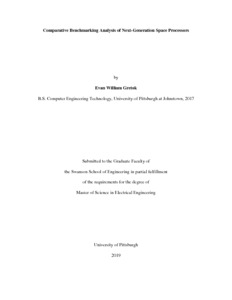Gretok, Evan
(2019)
Comparative Benchmarking Analysis of Next-Generation Space Processors.
Master's Thesis, University of Pittsburgh.
(Unpublished)
This is the latest version of this item.
![[img]](http://d-scholarship.pitt.edu/36185/1.hassmallThumbnailVersion/EWGretok_MSEE_Thesis_Submission.pdf)  Preview |
|
PDF (Final table caption format resolutions. Hopefully the last revisions.)
Submitted Version
Download (645kB)
| Preview
|
Abstract
Researchers, corporations, and government entities are seeking to deploy increasingly compute-intensive workloads on space platforms. This need is driving the development of two new radiation-hardened, multi-core space processors, the BAE Systems RAD5545(TM) processor and the Boeing High-Performance Spaceflight Computing (HPSC) processor. As these systems are in the development phase as of this writing, the Freescale P5020DS and P5040DS systems, based on the same PowerPC e5500 architecture as the RAD5545 processor, and the Hardkernel ODROID-C2, sharing the same ARM Cortex-A53 core as the HPSC processor, were selected as facsimiles for evaluation. Several OpenMP-parallelized applications, including a color search, Sobel filter, Mandelbrot set generator, hyperspectral-imaging target classifier, and image thumbnailer, were benchmarked on these processing platforms. Performance and energy consumption results on these facsimiles were scaled to forecasted frequencies of the radiationhardened devices in development. In these studies, the RAD5545 achieved the highest and most consistent parallel efficiency, up to 99%. The HPSC processor achieved lower execution times, averaging about half that of the RAD5545 processor, with lower energy consumption. The evaluated applications achieved a speedup of 3.9 times across four cores. The frequency-scaling methods were validated by comparing the set of scaled measures with data points from an underclocked facsimile, which yielded an average accuracy of 97% between estimated and measured results. These performance outcomes help to quantify the capabilities of both the RAD5545 and HPSC processors for on-board parallel processing of computationally-demanding applications for future space missions.
Share
| Citation/Export: |
|
| Social Networking: |
|
Details
| Item Type: |
University of Pittsburgh ETD
|
| Status: |
Unpublished |
| Creators/Authors: |
|
| ETD Committee: |
|
| Date: |
18 June 2019 |
| Date Type: |
Publication |
| Defense Date: |
22 March 2019 |
| Approval Date: |
18 June 2019 |
| Submission Date: |
25 March 2019 |
| Access Restriction: |
No restriction; Release the ETD for access worldwide immediately. |
| Number of Pages: |
55 |
| Institution: |
University of Pittsburgh |
| Schools and Programs: |
Swanson School of Engineering > Electrical and Computer Engineering |
| Degree: |
MSEE - Master of Science in Electrical Engineering |
| Thesis Type: |
Master's Thesis |
| Refereed: |
Yes |
| Uncontrolled Keywords: |
parallel, comparison, benchmarking, radiation-hardened, space, space-grade, processor, underclocking, scaling, frequency, parallelization, sensor, data, processing, algorithm, application, hyperspectral, image, imagery, Sobel, filter, image, processing, HPSC, RAD5545, P5020, P5040, Cortex-A53, ODROID-C2 |
| Date Deposited: |
18 Jun 2019 17:33 |
| Last Modified: |
18 Jun 2019 17:33 |
| URI: |
http://d-scholarship.pitt.edu/id/eprint/36185 |
Available Versions of this Item
-
Comparative Benchmarking Analysis of Next-Generation Space Processors. (deposited 18 Jun 2019 17:33)
[Currently Displayed]
Metrics
Monthly Views for the past 3 years
Plum Analytics
Actions (login required)
 |
View Item |








